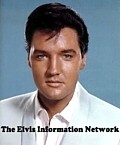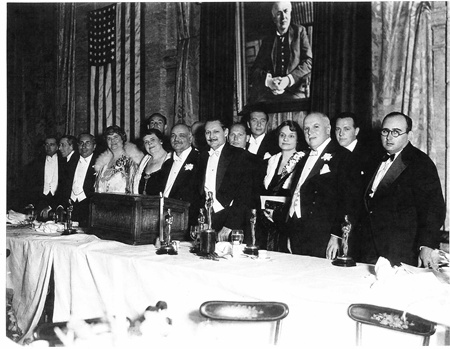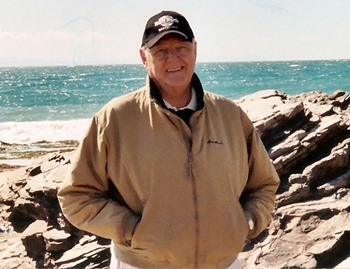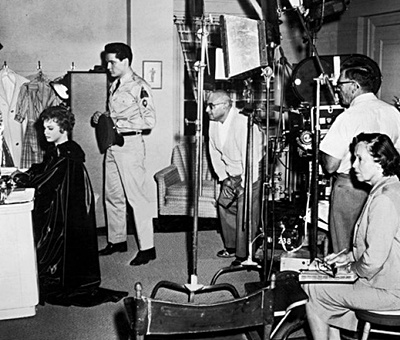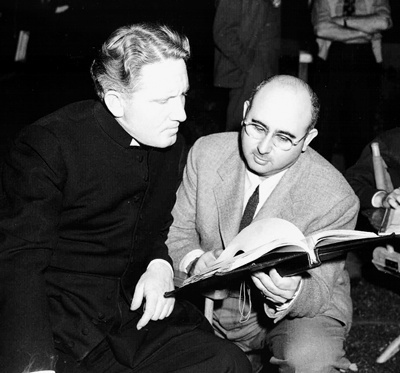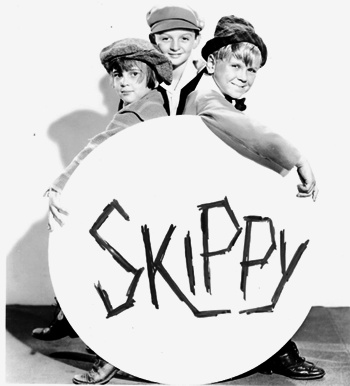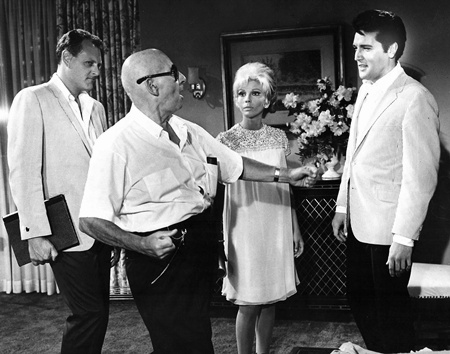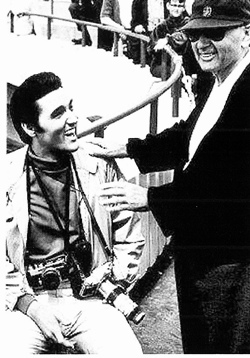 |
 |

BearManor Media, USA, 2013, Softcover, 361 pages, Softcover, Illustrated, Acknowledgements, Index, ISBN-13: 978-1593937553 Reviewed by Nigel Patterson, Feb 2014
Read EIN’s interview with Michael Hoey (originally published in 2007 and shortly to be UPDATED with new questions and answers in 2014) About the director: Norman Taurog was one of Hollywood’s most respected directors. He was, and still is, the youngest director to win an Academy Award (for Skippy in 1931). He also directed Spencer Tracy in his Oscar-winning role as Father Flanagan in Boys Town.
Norman Taurog (far right) at the 1931 Academy Awards Ceremony. Other notable figures in the picture include George Arliss, Louis B. Mayer and Lionel Barrymore During Taurog’s 52 years career he directed 87 films and worked with many of Hollywood’s greatest names. Taurog made nine films with Elvis. Norman Taurog’s Elvis Films: G.I. Blues Blue Hawaii Girls! Girls! Girls! It Happened At The World’s Fair Tickle Me Spinout (called California Holiday outside the USA) Double Trouble Speedway Live A Little, Love A Little
About the author: Michael Hoey (above) has the credentials to write about Hollywood and the film industry. He is a multi-award winning film and television editor, writer, director and producer. He was a friend of Norman Taurog and also Elvis, being involved in six Elvis films. Hoey wrote the screenplay for the politically controversial, Stay Away, Joe and the delightful (and underrated) sex farce, Live A Little, Love A Little, and was a contributing writer to four other Elvis films. On television, one of Hoey’s highlights was a multi-year run writing and directing the very popular show, Fame. His other books include Elvis, Sherlock and Me: How I Survived Growing Up in Hollywood and Inside Fame on Television: A Behind the Scenes History. ..........The Review.......... In his latest book, Elvis’ Favorite Director: The Amazing 52-Year Career of Norman Taurog, Michael Hoey has crafted a finely tuned narrative balance between three core elements: Elvis, Norman Taurog and Hollywood. Glorious chapters of in-depth discussion and fascinating minutiae about Elvis films are interspersed with equally fascinating chapters bringing to life the excitement and glamour of Hollywood and many of its most famous stars. In fact the cast of stars Taurog directed reads like a who’s who of film royalty! Among them are Spencer Tracy, W. C. Fields, Laurel and Hardy, Ethel Merman, Carole Lombard, Robert Taylor, David Niven, Deborah Kerr, Mickey Rooney, Judy Garland, Deanna Durbin, Maurice Chevalier, Cary Grant, Bing Crosby, Dean Martin, Jerry Lewis, Jane Russell, Fred Astaire and Ginger Rogers.
Director Norman Taurog with Cary Grant and Betsy Drake Based on countless hours of research and similarly countless interviews with people present during Taurog’s career, Hoey’s work is imbued with an authoritative legitimacy which goes way beyond the flimsy, third hand approach adopted by many mass market authors. Hoey’s discussion of Taurog’s films includes a detailed description of their filming and insightful discussion of the logistical and other issues that arose, all blended nicely with stories from behind the scenes which entertain and inform our knowledge and understanding of Elvis, Norman Taurog, the film industry and its larger-than-life stars. The author also covers in detail Norman Taurog’s personal life from his early acting endeavours and move to Hollywood at the age of 17 to his two marriages, family and serious health issues which, in Taurog’s final years, meant his body was wracked by pain before ultimately costing him his life. The picture painted of Norman Taurog the person is of a genuine and uber talented human being with a great interest in those he worked with; an astute director who knew how to get the best out of a film script, be it great or mediocre. Hoey is a gifted writer and his luculent discussion of both Taurog’s and Hollywood’s early years is impressive; his attention to detail bringing to life the romance and atmosphere of a golden time in Tinseltown’s rich and sometimes scarred history. Michael Hoey had an interesting entry to the inner world of Hollywood. His account provides insight to the political influences which affected Hollywood and social mores of the early 1960s:
On Norman Taurog’s career and Elvis’ film canon Hoey offers valuable analysis and insight as well as a plethora of little known and fascinating facts. In discussing what is the exemplar for the ‘Elvis film vehicle’: Blue Hawaii, Hoey perceptively observes:
Director Norman Taurog, Elvis and Juliet Prowse on the set of G.I. Blues And how many fans knew that the original choice to play Elvis’ leading lady in Blue Hawaii was his G.I. Blues co-star, Juliet Prowse? The story of how Prowse lost the role reveals much about precious ego in the entertainment business. Hoey weaves a detailed panorama which at times is enthralling and at other times humorous. He notes that director Taurog’s penchant for strong physicality in his films was evident from his early years:
About the filming of the 1936 film, Strike Me Pink, starring Eddie Cantor and Ethel Merman, Hoey observes an important element of Taurog’s impressive directorial style:
Film lovers will enjoy non-Elvis chapters dealing with Taurog’s work with Judy Garland and Mickey Rooney, Cary Grant and his six films with (Dean) Martin and (Jerry) Lewis. There are also fascinating accounts of the tense, behind the scenes dramas in filming movies such as The Adventures of Tom Sawyer (1938) and the difficulties faced while filming with the legendary and well- loved Spencer Tracy. Tracy’s deep-rooted psychological issues and fits of depression during the filming of Boys Town led to bouts of drinking and production delays for the studio.
Norman Taurog with acting legend Spencer Tracy during the filming of Boys Town However, the reasons behind Taurog’s disdain for one of Elvis’ musical heroes, Mario Lanza, may cause dissonance for some Elvis fans. In relation to the filming of Lanza’s The Toast of New Orleans (1950), Hoey records:
On the tangential issue of Lanza’s relatively early passing (and similarly that of Elvis, Judy Garland and Robert Walker), Hoey insightfully questions whether there might not be a self-destructive chromosome in the DNA of some creative personalities! Given the period of Taurog’s career, Hoey brilliantly weaves a multi-varied, mosaic of early 20th century social history into his narrative, evoking wonderfully full and expressive images of characters, places and times gone by. From the little remembered, but horrific Influenza Pandemic of 1918-19 (which in the USA alone claimed the lives of 675,000 people), to the ‘romantically’ well-remembered Prohibition era:
This film poster for Skippy, one of Norman Taurog’s most famous films starred his nephew, Jackie Cooper. Sadly, Taurog and Cooper were not to enjoy the greatest of personal relationships In both an indictment of one aspect of the often overly legalistic and opportunistic capitalist system and also an account of ‘spin-off’ merchandise marketing in the first half of the 20th century, Hoey recounts this story related to Taurog’s film version of the Skippy cartoon character (created by Percy Crosby):
The inclusion of reviews of Elvis’ films (the late Bosley Crowther, long time film critic for The New York Times makes numerous appearances throughout Elvis’ Favorite Director) allows the reader to obtain a feel for how Elvis was perceived, including the recurring theme of Elvis’ appearance and the slide in his box-office appeal. In a review of California Holiday, one London reviewer commented:
*Reviewers note: TIME magazine in its review of Spinout (aka California Holiday) also commented on Elvis’ weight gain Tickle Me is a film which divides fans and critics. A “quickie” filmed in only 23 days it is often unfairly criticised for its low production values including non-location filming (a cost saving measure), lack of “new” songs (another cost saving measure) and a routine script (re-written in parts by Norman Taurog and Michael Hoey). In this reviewer's opinion, much of the criticism is undeserved; as while not the greatest film ever made, Tickle Me does feature a strong set of musical numbers, interesting, quirky characters and abundant doses of humor throughout its inoffensive and pleasant narrative. After all, the film is supposed to be a tongue-in-cheek ‘B’ grade outing and not Hamlet or Macbeth! Michael Hoey was involved with Norman Taurog in the making of Tickle Me. In Elvis' Favorite Director, Hoey provides a neat overview and appreciation of the film including media reviews of Tickle Me which are particularly interesting when they comment on Elvis’ performance and the direction of Norman Taurog. The Hollywood Reporter opined:
And the Variety review commented on the ghost sequence:
Hoey’s ability to craft his words and build the moment is nicely on display in this passage:
Norman Taurog, Michael Hoey, Elvis and Nancy Sinatra on the set of Speedway There are many amusing and informative anecdotes throughout Elvis’ Favorite Director:
One of the major strengths of Elvis’ Favorite Director is the painstaking research undertaken by the author. As a Hollywood insider, Hoey was able to access information the media cannot, and in so doing is able to report accurately on issues, rather than based on conjecture or rumor as is commonplace in contemporary media. On the logistics of filming It Happened At the World’s Fair, Hoey writes:
And in relation to the financial success of Elvis’ films and his salary:
Hoey’s record of Norman Taurog’s final years is appropriately compassionate. Legally blind and becoming increasingly reclusive, Taurog’s health issues worsened with circulatory problems resulting in amputation of his toes. His body would then battle cancer until his death in 1981 aged 82. It was a sad end to a wonderful career. Reflecting back on Taurog’s Elvis films, Hoey offers this insightful comment:
As a measure of the character of Norman Taurog and what Elvis thought of him, Hoey states:
Elvis’ Favorite Director is dotted with archival photos and film stills of Norman Taurog, Elvis and many other great Hollywood stars. The only thing missing is a chronological listing of the Norman Taurog film catalog. Verdict: Michael Hoey’s latest book, Elvis’ Favorite Director: The Amazing 52-Year Career of Norman Taurog, is a thoroughly engrossing, wonderfully entertaining, well-crafted and insightful record of its subject(s). It is rich in textured information, which unlike the information found in many other books about Elvis, adds appreciably to the complex tapestry that makes up his life and career. As part Norman Taurog biography; part Hollywood, Elvis film and socio-political history and part delightful anecdote, Elvis’ Favorite Director is an energetic narrative canvas which is essential reading for anyone interested in Elvis, the incredible (indeed it was amazing!) career of director Norman Taurog or the colourful history of Hollywood. A cracking read!!
|
|
